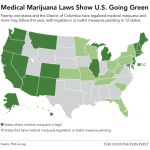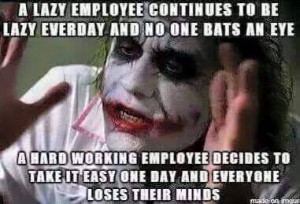The 12 Companies in America Paying the Least
Category: Interesting Facts Tags: Interesting Leave a Comment
This post is from 2012…. But I can’t imagine that much has changed… Especially with some of these companies.
The gap between rich and poor is well illustrated by the large multi-billion dollar corporations employing thousands of low-wage workers. With the Great Recession over, not only are many of these companies now hitting record profits, but their executive pay remains spectacularly high. Meanwhile, according to a report released by the National Employment Law Project, the current federal minimum wage the workers are often paid, is worth 30% less than it was in 1968 in terms of purchasing power
These employers fall into one of two categories. They are are either large national restaurant chains such as McDonald’s, Burger King, and Starbucks, employing tens of thousands of cashiers and cooks. Seven of the 12 companies fall into this category. The others are large national retailers, employing tens of thousands of cashiers and salespeople, like Walmart, Target, and Sears.
In addition to low wages, many of these companies have a history of poor labor relations that extends beyond underpaying their employees. Long hours, unsafe or unpleasant working conditions, limited benefits and restricting access to full-time work, often accompany minimum wage jobs in many of these companies.
The recession has affected every company on this list. Many used the downturn to explain reductions in employee benefits, long hours, and continued low pay. However, the recession is over for a majority of minimum-wage employers. Nine of the 12 companies on this list have been profitable for the past three years. Of these 12 companies, a full ten had higher revenue compared to 2010.
Despite this fact, improvements in employee benefits or an increase in pay have not materialized for workers at most of the companies on the list.
Based on the National Law Employment Project’s report, 24/7 Wall St. Identified the 12 largest companies in industries that are primarily low-wage employers. The report also provided the most recent available data on the total size of the companies’ workforces, the recent performance of the corporations in terms of revenue and profit, and the highest executive pay at these companies. 24/7 Wall St. also reviewed revenue, income, and the number of stores from company filings.
These are the companies paying Americans the least.
> U.S. workforce: 159,000
> Highest compensation: $53,281,505
> Revenue: $17.26 billion
> Net income: -$152 million
> No. of U.S. stores: 1,102
11. Darden Restaurants
> U.S. workforce: 165,475
> Highest compensation: $8,480,148
> Revenue: $8.00 billion
> Net income: $475.5 million
> No. of U.S. stores: 1,994
A lawsuit filed in September charged Darden Restaurants, Inc. (NYSE: DRI) with violating federal labor laws by underpaying thousands of servers across the country at its Olive Garden, LongHorn Steakhouse and Red Lobster chains. The action represented employees who who worked for the company going back to Aug. 2009 and sought millions of dollars in back wages and other compensation. “We’re seeking not only to correct the wrongs that have occurred at Darden, but hopefully this will stimulate change across the country,” said a lead attorney in the case. While the compensation of CEO Clarence Otis Jr. did drop from $8.48 million in 2011 to $8.08 million in 2012, that cannot be much comfort to those at the bottom of the pay scale at Darden.
10. Wendy’s
> U.S. workforce: 168,672
> CEO compensation: $16,537,725
> Revenue: $2.13 billion
> Net income: $12.9 million
> No. of U.S. stores: 6,594
The Wendy’s Company (NYSE: WEN) efforts to remake itself appear to be paying off. Same-store sales have risen for six straight quarters, and the company tries to sidle away from the traditional fast-food category toward the fast-casual arena occupied by the likes of Panera Bread Co. (NASDAQ: PNRA) and Chipotle Mexican Grill Inc. (NYSE: CMG). Investors have been rewarded with a recent boost to the quarterly dividend to $0.04 per share from $0.02 per share, though shares have been largely range-bound between $4 and $5 for almost four years. It remains to be seen whether Wendy’s employees will benefit from the recent success. It’s interesting to note that the top compensation package at Wendy’s is greater than those at McDonald’s or Starbucks.
9. Macy’s
> U.S. workforce: 171,000
> CEO compensation: $17,650,702
> Revenue: $26.41 billion
> Net income: $1.26 billion
> No. of U.S. stores: 842
Unlike many of the companies on the list, some of Macy’s (NYSE: M) workers are members of a union and they have achieved several concessions from the company. Specifically, next spring, senior members of the retail unions at New York City’s Bloomingdales and Macy’s will be able to choose their preferred hours of work by setting their own schedules and vacation time. According to UPI, “these gains … are in contrast to the scheduling uncertainties rampant in an increasingly ‘just in time’ work force.” While workers count this as a small victory, only 4% of Macy’s and Bloomingdales’ combined 171,000 employees are members of a union.
8. DineEquity
> U.S. workforce: 173,350
> CEO compensation: $5,392,402
> Revenue: $1.08 billion
> Net income: $75.2 million
> No. of U.S. stores: 3,569
7. Starbucks
> U.S. workforce: 176,533
> CEO compensation: $16,079,480
> Revenue: $13.30 billion
> Net income: $1.38 billion
> No. of U.S. stores: 12,903
Unlike other companies on the list, some of Starbucks Corp.’s (NASDAQ: SBUX) workers are represented by a union. The Starbucks Workers Union has argued that the company has cut benefits and stagnated salaries while reporting record profits. Of course, on its website the company claims that it is dedicated to “earning the trust and respect of our customer, partners and neighbours” by “being responsible and doing things that are good for the planet and each other.”
6. Burger King
> U.S. workforce: 191,815
> CEO compensation: $4,015,619
> Revenue: $2.33 billion
> Net income: $107.0 million
> No. of U.S. stores: 7,453
In August, representatives of Burger King Holdings Inc. (NYSE: BKW), Subway and McDonald’s went to Washington to complain to lawmakers about the Affordable Care Act. Steen Wiborg, president of Burger King in North America, told The Wall Street Journal that “Many of our franchisees will struggle with how to reconcile the financial implications … and will likely take other measures to reduce costs.” Burger King, which had revenue of $2.3 billion last year, currently offers a limited benefit plan, which it describes as “the red carpet treatment” and that is also unpopular with its workers.
5. Sears
> U.S. workforce: 264,000
> CEO compensation: $9,932,924
> Revenue: $41.57 billion
> Net income: -$3.11 billion
> No. of U.S. stores: 3,510
Many companies like to tout how important their employees are, and Sears Holdings Corp. (NASDAQ: SHLD) is no different. “Our associates are at the heart of our company and we value teamwork, integrity, and positive energy,” says the company’s website. Unfortunately for the employees, the operator of Sears and Kmart has struggled in recent years, as evidenced by its recent massive $3.11 billion net loss, despite having revenue of $41.6 billion. In addition, similar to Walmart and Target, Sears and Kmart stores will be open on Thanksgiving for early Black Friday shopping, meaning the employees will have to work this holiday. Sears said it expects holiday hiring to be about the same as a year ago, while Walmart, Toys”R”Us and other retailers increased their seasonal hire
4. Target
> U.S. workforce: 365,000
> CEO compensation: $19,707,107
> Revenue: $69.87 billion
> Net income: $2.93 billion
> No. of U.S. stores: 1,763
3. McDonald’s
> U.S. workforce: 859,978
> CEO compensation: $4,073,748
> Revenue: $27.01 billion
> Net income: $5.50 billion
> No. of U.S. stores: 14,098
McDonald’s (NYSE: MCD) is the king of fast-food, with revenue greater than any other restaurant operator on this list, and far more locations as well. The company’s website offers a long list of awards and recognition for the diversity of its workplace. But even McDonald’s is not immune to economic pressures. The company just reported its first monthly drop in global revenue at locations open more than a year, down 1.8% in October. McDonald’s USA president, Jan Fields was subsequently ousted to be replaced by Jeff Stratton, who is currently global chief restaurant officer.
2. Yum! Brands
> U.S. workforce: 880,330
> CEO compensation: $20,411,852
> Revenue: $12.63 billion
> Net income: $1.33 billion
> No. of U.S. stores: 16,006
Because Yum! Brands Inc. (NYSE: YUM), the operator of the Taco Bell, Pizza Hut and KFC chains, is one of the biggest employers of low wage workers, it takes benefits seriously. According to watchdog group Center for Media and Democracy, the fast food giant co-chaired the labor and business regulation subcommittee of the American Legislative Exchange Council, a “corporate-funded bill mill” that encourages laws that benefits its corporate members. At a 2011 meeting, attendees considered model bills designed to override paid sick leave legislation in the states. In 2012, following negative press over ALEC initiatives and the departure of McDonald’s, Wendy’s, Yum! Brands became one of several large companies to abandon the council.
1. Walmart
> U.S. workforce: 1,400,000
> CEO compensation: $18,131,738
> Revenue: $446.95 billion
> Net income: $15.70 billion
> No. of U.S. stores: 3,868
The labor practices of Wal-Mart Stores Inc. (NYSE: WMT) have long received negative attention in the press, but that has not affected investors much. WMT’s share price rose more than 48% in the past five years. In 2008, Walmart agreed to pay $640 million in settlements of dozens of class-action lawsuits that claimed the company deprived workers of pay for time worked. In October a class action lawsuit was filed in a Chicago federal court alleging that the retailer had violated minimum wage and overtime laws. Walmart workers have begun to strike, and some plan to walk off the job on Black Friday, the busiest shopping day of the year. Walmart has filed an unfair-labor-practice complaint against the United Food and Commercial.
Courtesy of 24/7 Wall St
More From I Hate Working in Retail
 Fast-Food CEOs Making 1,200 Times Workers’ Wages Have No Idea What Their Greed Does To Employees
Fast-Food CEOs Making 1,200 Times Workers’ Wages Have No Idea What Their Greed Does To Employees This Map Shows Just How Quickly America Has Embraced Retail Marijuana
This Map Shows Just How Quickly America Has Embraced Retail Marijuana 10 Things that the Fast Food industry doesnt want you to know…..
10 Things that the Fast Food industry doesnt want you to know….. How America’s Largest Retailer Walmart became its favourite punching bag
How America’s Largest Retailer Walmart became its favourite punching bag The Sad, Slow Death of America’s Retail Workforce
The Sad, Slow Death of America’s Retail Workforce




















Recent Comments